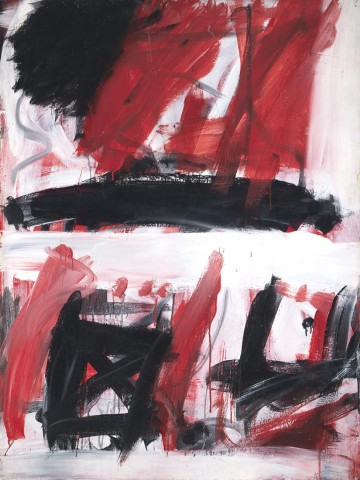UNTITLED (RED, BLACK AND WHITE), c.1962 – 65
TONY TUCKSON
synthetic polymer paint on composition board
120.0 x 90.0 cm
bears inscription verso: T. TUCKSON / CAT.10. WATTERS ‘75
Watters Gallery, Sydney
John Lane, Sydney, acquired from the above in 1975
Private collection, Sydney, acquired from the above in 1980
Tuckson ’62 – ’65, Watters Gallery, Sydney, 27 August – 13 September 1975, cat. 10
Genesis of a Collection. Art from the Harding Family Collection, University of the Sunshine Coast, Queensland, 2 May – 6 June 2002 (label attached verso)
Widely regarded as one of the finest abstract artists of his generation, Tony Tuckson held only two solo exhibitions during his lifetime. Following the second at Watters Gallery, Sydney – and his premature death – in 1973, Sandra McGrath wrote in Art and Australia that ‘[he] was recognised almost overnight for what he was – the best Action Painter in Australia and one of the country’s most important artists’.1 Born to British parents, Tuckson had studied art in England from 1937 – 40 and after the Second World War, at the East Sydney Technical College, including what he described as his most influential lessons with pioneering abstract artists Grace Crowley and Ralph Balson. By the time of the 1973 exhibition he had been painting for more than thirty years, but few apart from a handful of intimates had ever seen his work.2 The reason for this was the conflict he rightly perceived between his art practice and his professional role at the Art Gallery of New South Wales, where he worked from 1950 until 1973, as assistant director and then deputy to Hal Missingham.
Although he worked in isolation, Tuckson was deeply immersed in the world of art and his role at the Gallery exposed him to a wide range of creative influences. Links with contemporary abstraction, and especially the work of American abstract expressionists, are clear. Tuckson established the Gallery’s Aboriginal and Melanesian art collections and his deep knowledge of Indigenous Australian art was another influence which, according to his wife Margaret, ‘first interested him for its casual way of filling an area, the lack of worry about shapes spilling over outlines’.3
Untitled (Red, Black and White), c.1962 – 65, is part of Tuckson’s second series of abstracts, a group of paintings made during the first half of the 1960s, which are distinguished by a bold palette restricted to the three colours of its title.4 Applied with a broad brush, blocks of colour reverberate against one another, as loose linear forms and dots of paint punctuate the open fields of colour. In this and related works, including Large shapes, red black, c.1961 (National Gallery of Australia, Canberra), the gestural freedom of Tuckson’s intuitive style and his belief that ‘when you start worrying about the position of a mark, you cease to paint’4, are on clear display. Something of Tuckson’s process is also visible in this work, the dribbles of red and black paint (especially in the bottom half of the panel) which point to the immediacy of his approach, and the layers that reveal the ‘incessant activity of concealment, correction and accumulation’ of his painting, creating both visual and physical texture.5
Reviewing Tuckson’s 1973 exhibition, James Gleeson wrote, ‘What he is on about is the act of painting. His pictures are about what it feels like to paint a picture’.6 This interpretation, and its emphasis on the significance for Tuckson of the physical act of painting itself, is echoed by the eloquent words of another abstract artist, Aida Tomescu who has recently written, ‘Tuckson’s paintings transcend being pinned down to one meaning, one subject. What is being expressed here is painting itself; its capacity to be about everything at once, its subjects and meanings always multiple’.7
1. McGrath, S., ‘Tony Tuckson’, Art and Australia, Sydney, vol. 12, no.2, 1974, p. 156
2. Tuckson occasionally submitted works to group exhibitions during the 1950s, but had stopped exhibiting by the 1960s by which time his responsibilities and public profile at the AGNSW had increased. The decision to exhibit publicly in 1970 and 1973 coincided with a scaling back of curatorial responsibilities, apart from his work with the Aboriginal and Melanesian art collections. See Mimmocchi, D., ‘Tony Tuckson: The Art of Transformation’ in Mimmocchi, D., (ed.). Tony Tuckson, exhibition catalogue, Art Gallery of New South Wales, Sydney, 2018, p. 20
3. Margaret Tuckson quoted in Thomas, D., Free, R., Legge, G., Tony Tuckson, Craftsman House, Sydney, 1989, p. 39
4. McGrath, op. cit., p. 156
5. See Mimmocchi, op. cit., pp. 42 – 45
6. Gleeson, J., ‘The travail of painting’, Sun-Herald, Sydney, 22 April 1973
7. Tomescu, A., ‘Fluid Construction’ in Mimmocchi, op. cit., p. 77
KIRSTY GRANT
